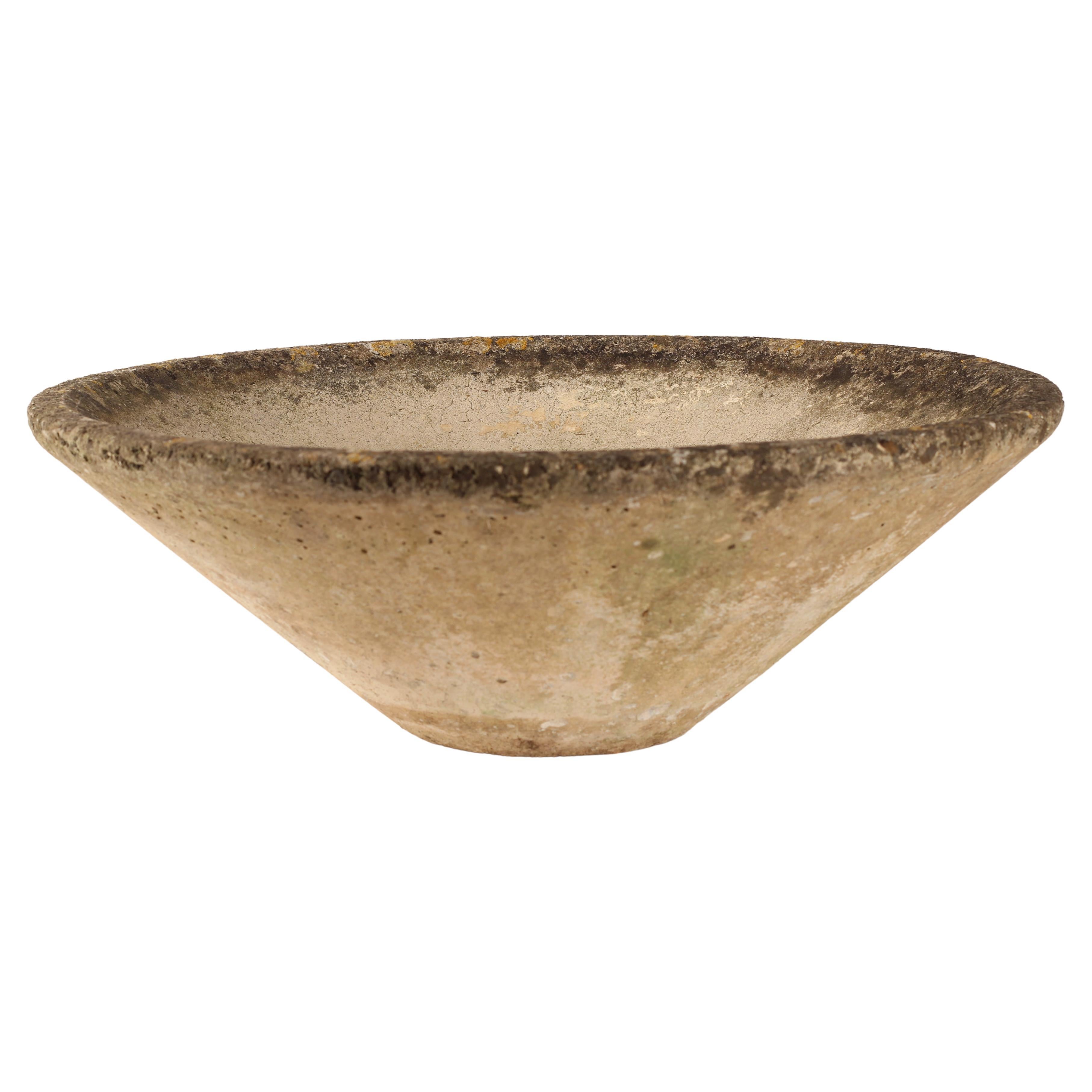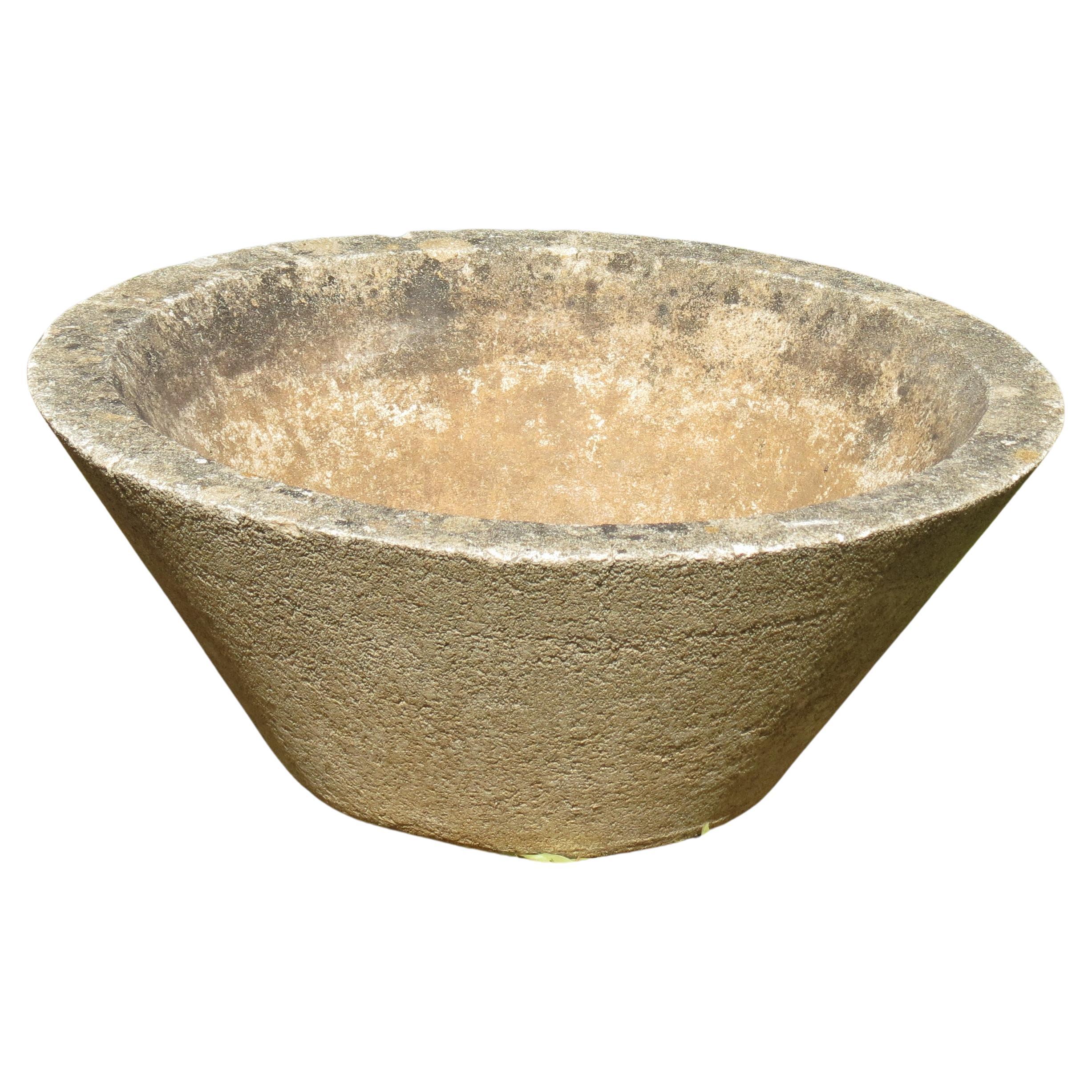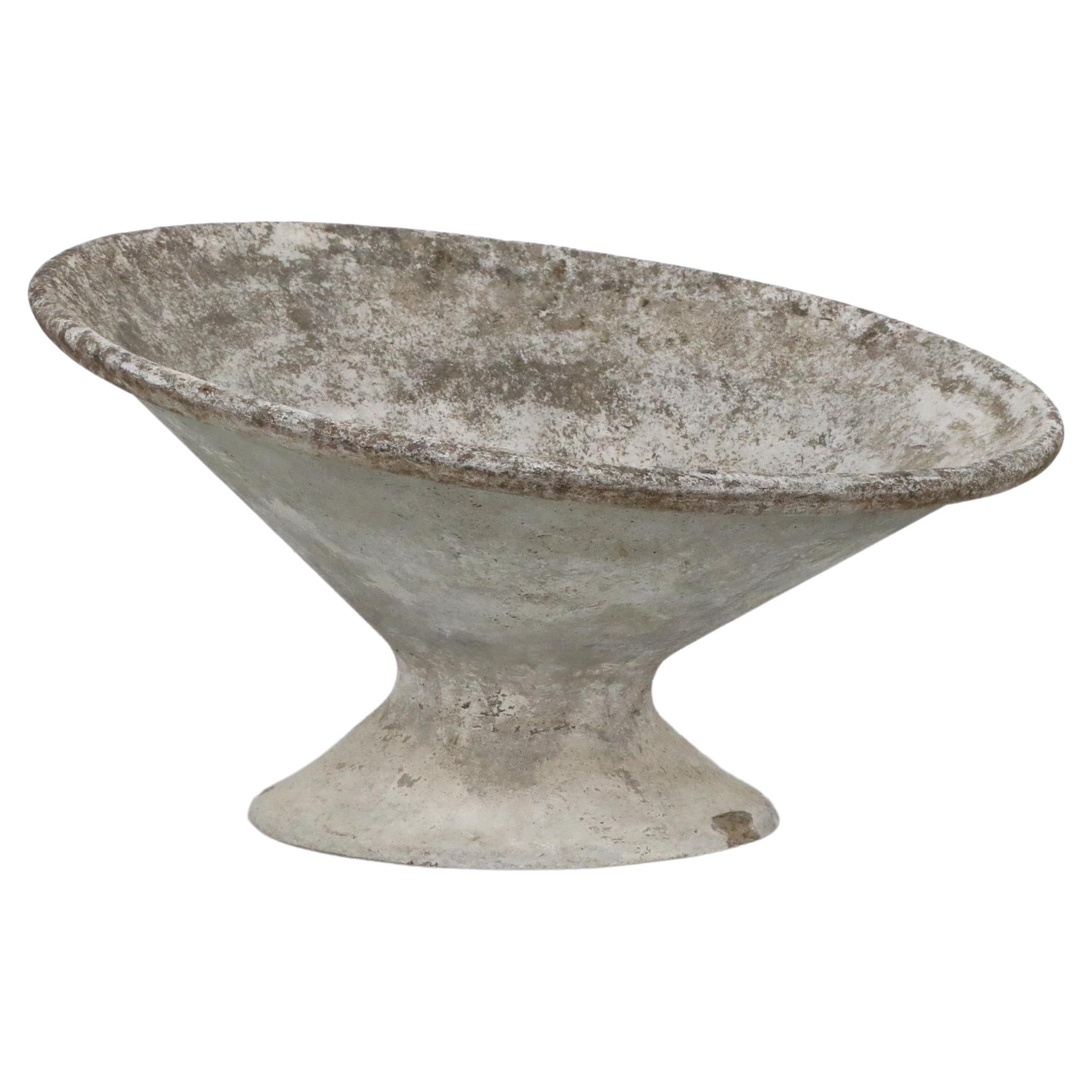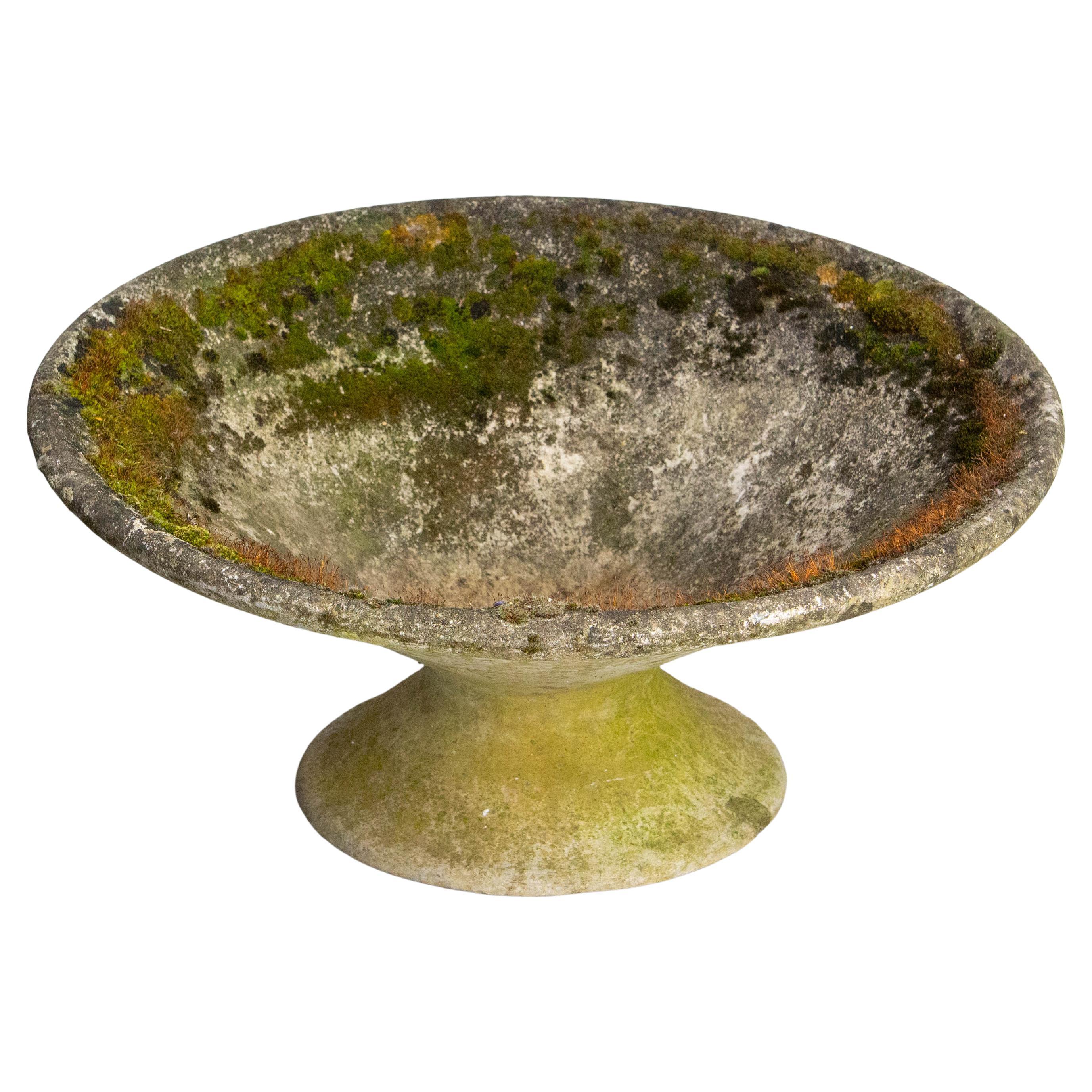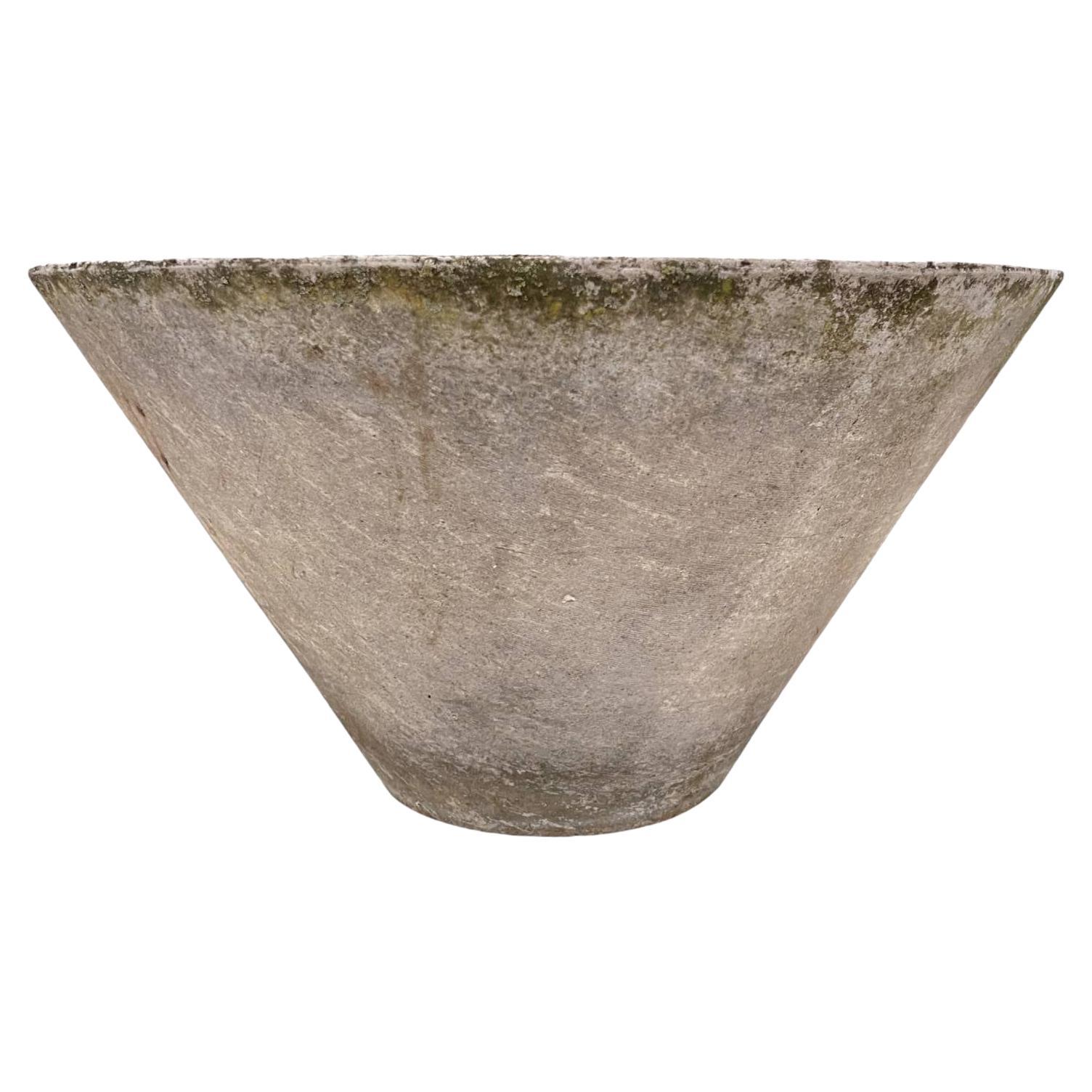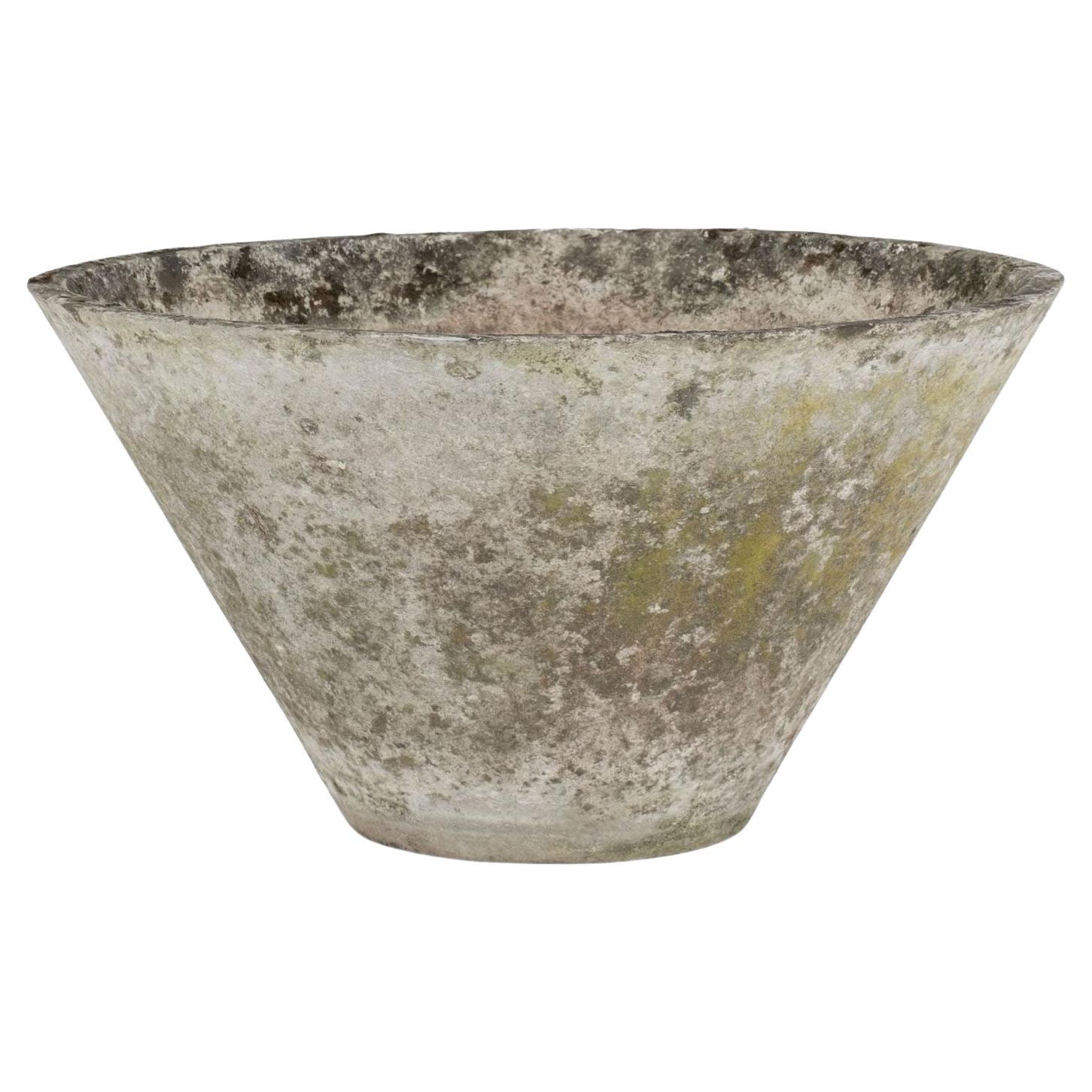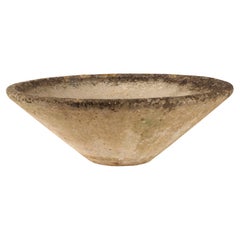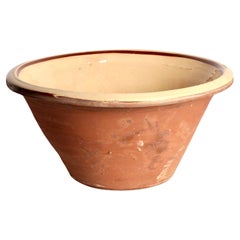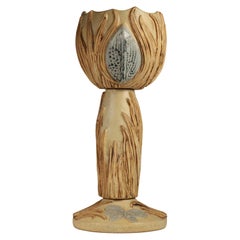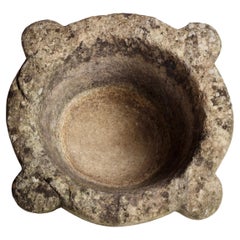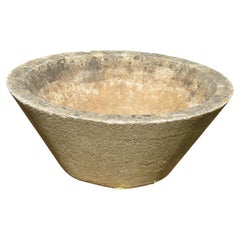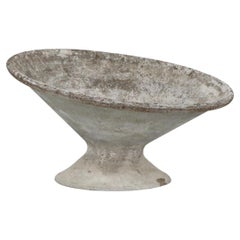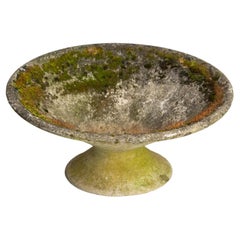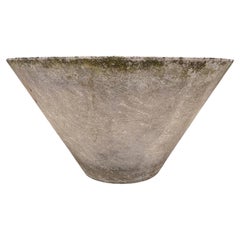Items Similar to Willy Guhl inspired concrete Planter in cone shape made in England 1960’s
Want more images or videos?
Request additional images or videos from the seller
1 of 19
Willy Guhl inspired concrete Planter in cone shape made in England 1960’s
$1,035.49
£756
€888.59
CA$1,429.64
A$1,584.97
CHF 832.96
MX$19,397.39
NOK 10,402.85
SEK 9,764.11
DKK 6,632.78
About the Item
Mid-Century Modern Concrete Planter – 1960s English Design
Discover this exquisite Mid-Century Modern concrete planter from England, dating back to the 1960s. Crafted from high-quality cast cement, this planter boasts exceptional strength and durability, making it an ideal choice for both indoor and outdoor use. Its elegant tapered cone shape is emblematic of the mid-century modern design movement, reflecting the era's emphasis on clean lines and functional aesthetics.
The planter features a beautifully worn and aged patina, developed through years of weathering and exposure to the elements. This natural aging process enhances its character, adding a unique charm that complements various design styles, from modernist to rustic. Similar pieces can be found in the iconic Brutalist mixed development of the Barbican in London, as well as throughout Switzerland, France, and Austria, highlighting its international appeal and significance.
This concrete planter is one of a pair we currently have in stock, making it a fantastic option for creating a cohesive look in your home or garden. Weighing 24 kg, it is robust enough to withstand the elements while providing a stylish home for your favorite plants.
**General Note**: Please note that shipping quotes provided by 1stdibs are indicative only. We encourage you to contact us directly with your shipping requirements, and we will work to source the most competitive shipment method and rate for each individual piece. Embrace the charm of Mid-Century Modern design with this stunning concrete planter, perfect for elevating your space.
- Similar to:Willy Guhl (Designer)
- Dimensions:Height: 8.08 in (20.5 cm)Diameter: 24.02 in (61 cm)
- Style:Mid-Century Modern (Of the Period)
- Materials and Techniques:
- Place of Origin:
- Period:
- Date of Manufacture:1960’s
- Condition:Wear consistent with age and use. In good structural condition with plenty of patina from years of wear.
- Seller Location:London, GB
- Reference Number:1stDibs: LU2868327455052
About the Seller
5.0
Platinum Seller
Premium sellers with a 4.7+ rating and 24-hour response times
Established in 2015
1stDibs seller since 2017
196 sales on 1stDibs
Typical response time: 1 hour
- ShippingRetrieving quote...Shipping from: Maldon, United Kingdom
- Return Policy
Authenticity Guarantee
In the unlikely event there’s an issue with an item’s authenticity, contact us within 1 year for a full refund. DetailsMoney-Back Guarantee
If your item is not as described, is damaged in transit, or does not arrive, contact us within 7 days for a full refund. Details24-Hour Cancellation
You have a 24-hour grace period in which to reconsider your purchase, with no questions asked.Vetted Professional Sellers
Our world-class sellers must adhere to strict standards for service and quality, maintaining the integrity of our listings.Price-Match Guarantee
If you find that a seller listed the same item for a lower price elsewhere, we’ll match it.Trusted Global Delivery
Our best-in-class carrier network provides specialized shipping options worldwide, including custom delivery.More From This Seller
View AllWilly Guhl Inspired Concrete Planter in Cone Shape Made in England, 1960’s
By Willy Guhl
Located in London, GB
Mid-Century Modern Concrete Planter – 1960s English Design
Discover this exquisite Mid-Century Modern concrete planter from England, dating ba...
Category
Vintage 1960s English Mid-Century Modern Planters, Cachepots and Jardini...
Materials
Concrete
A large English 19th Century Dairy Bowl from The Cotswolds
Located in London, GB
This wonderful over sized 19th Century Dairy Bowl was found in the darkest depths of The historic Cotswolds in England. A Hand made Dairy Bowl that we procured from a traditional che...
Category
Antique 1890s English Country Decorative Bowls
Materials
Pottery, Terracotta
Mid Century Modern Ceramic Jardinière by Bernard Rooke
By Bernard Rooke
Located in London, GB
An organic and Brutalist style Jardine which would work perfectly with trailing foliage.
Bernard Rooke (born 1938) is a British artist and studio potter. Rooke has exhibited his "Brutalist" ceramics and painting both in the UK and abroad with work in many collections both public and private including the Victoria and Albert Museum, Cleveland Museum of Art, Nuffield Foundation, Röhsska Museum in Sweden and the Trondheim Kunstmuseum in Norway.
Bernard Rooke attended Ipswich School of Art studying painting and lithography before going on to study at Goldsmiths College of Art. It was while studying here that he decided to take up pottery. Although unfamiliar with this craft and tradition, he found that working with clay provided new opportunities for freedom of interpretation and creativity.
In 1960 Rooke set up his first pottery in Forest Hill in South London along with Alan Wallwork. It was a very small room with enough space for a small electric kiln. He was initially using mainly hand building, coiling, blocking and slabbing techniques. While researching ideas, he was supporting himself by part-time lecturing at London University, Goldsmiths College and St Mary's College. In addition, Rooke's membership of 'The Craftsman Potters' Association' enabled him to show his work in a shop in Carnaby Street in London.
In 1967, both the need for a larger working space and becoming disillusioned with living in London spurred Rooke into moving out of the city and to an old mill building in Swilland in Suffolk. Rooke wanted to widen the range of work so as to become more commercial. With the birth of his son, Aaron, and much needed work to be done on the mill, it was important to be able to make a living.
In 1968, the Grand Metropolitan Hotel commissioned Rooke to make 120 standard lamps, 120 table lamps as well as a 24 foot long ceramic mural and another 9 foot high, which incorporated interior lighting. The money from the commission helped to pay for much needed restoration work on the mill.
By the 1970s, a gallery space was opened in the windmill and run by Susan Rooke, Bernard's wife, selling work to locals and tourists as well as to American airmen based nearby. The vision for Mill Gallery was beginning to develop and alongside this a reputation was building bringing in a good source of income.
Sons Aaron and Felix were becoming more involved with the running of the pottery, giving Bernard more time to develop new ideas and designs and more time to continue with his painting. In 2004, the Rooke family decided not to sell to the public through the gallery anymore and close the pottery to concentrate more on painting and printmaking.
In 2017 Bernard's lighting was featured in the Exhibition: “Glass, Light, Paint & Clay” at the Peterborough Museum and Art Gallery. The exhibition featured four artists: Bernard Rooke, John Maltby...
Category
Vintage 1970s English Brutalist Planters and Jardinieres
Materials
Clay
Antique English Marble Mortar Bowl – Hand-Carved Kitchen & Apothecary Vessel
Located in London, GB
Antique English Marble Mortar Bowl – Hand-Carved Kitchen & Apothecary Vessel
This exquisite antique English marble mortar bowl is a captivating testament to the rich history and cra...
Category
Antique Early 19th Century English Rustic Decorative Bowls
Materials
Stone, Marble
Scandinavian Modern Swedish Bowl by Carl Harry Stalhane and Maker Rorstrand
By Rörstrand, Carl-Harry Stålhane
Located in London, GB
Swedish ceramic artist Carl-Harry Stålhane (1920- 1990) played a major role in popularizing Swedish pottery during the 20th century, working for more than three decades at Rörstrand, one of the oldest ceramics manufacturers in Europe. During his long tenure at Rörstrand, Stålhane was responsible for small-batch studio pieces, mass-produced tableware , and all manner of decorative accessories .
Born in 1920 in Mariestad, Sweden, Stålhane began working at Rörstrand in 1939 as a decorative painter, assisting Danish-Finnish ceramic artist, designer, and sculptor Gunnar Nylund (1904-1997). During this time, Stålhane decorated various ceramic pieces, most notably Nylund’s Flambé range (1939s), quickly establishing himself as a talented ceramic artist. Inspired by the desire for new products during the postwar economic boom, Stålhane went from being a talented decorator to an exceptional ceramic artist.
In 1943, Stålhane caught the eye of Swedish artist Isaac Grünewald (1889-1946), who was visiting Rörstrand. Grünewald was so impressed with Stålhane’s work that he took him on as a student, and from 1943 to 1946, Stålhane studied art at Grünewald's Art School in Stockholm. Subsequently from 1947 until 1948, he studied sculpture at Académie Colarossi in Paris.
During the 1950s, Stålhane’s work appeared in several solo exhibitions in Sweden, the United Kingdom, and the United States. His Blanca Tableware range (c. 1955) won numerous international prizes and was in high-demand. In 1958, Stålhane succeeded Nylund as Artistic Director and Chief Designer at Rörstrand.
In 1960, Stålhane unveiled a new collection at Stockholm’s Galerie Blanche. Featuring dark stoneware pieces made from local clays, this collection represented a bold departure from the soft, restrained shapes of the 1950s. It has since been praised for its precient aesthetic that would influence the look of ceramics for more than a decade.
From 1963 until 1971, Stålhane taught ceramics at the Art Industrial School in Gothenburg. For a short time, he also was the Design Director at the Swedish factory Upsala Ekeby, which in addition to porcelain, produced tile, brick, and glass.
Stålhane eventually left Rörstrand in 1973 in order to establish his own ceramic company, Designhuset, in Lidköping, where he further experimented with local clays and minerals. Stålhane continued to work until his death in 1990. Today, Designhuset is a school for ceramists and model-makers.
Over the course of his career, Stålhane created several public works for The Commerce Trust Company in Kansas City, Missouri, and for Volvo in Gothenburg, Sweden. His work is represented at several international museums, including Stockholm’s Nationalmuseum and New York’s MoMA.
Rörstrand is the second oldest brand of ceramics in Europe and can be found in homes all across Sweden and Europe. Rörstrand’s long legacy includes some of Europe’s most iconic ceramics collections including Swedish Grace, Mon Amie, Ostindia, Filippa...
Category
Vintage 1950s Swedish Scandinavian Modern Ceramics
Materials
Ceramic, Stoneware, Pottery
Wabi-Sabi Vintage Wooden Bowl, Lombok, Organic Sculptural Centerpiece
Located in London, GB
Wabi-Sabi Lombok Wooden Bowl, Sculptural Hand-Carved Form, circa 1940s
A monumental hand-carved wooden bowl from Lombok, Indonesia, dating to the 1940s. Carved from a single block o...
Category
Vintage 1940s Indonesian Folk Art Planters, Cachepots and Jardinières
Materials
Wood
You May Also Like
1970s Concrete Conical Garden Planter
Located in Stow on the Wold, GB
1970s concrete conical planter, made from solid concrete.
Very nice patina, small chip to one edge, nicely weathered.
Drainage hole to the base.
ST1615
Category
Mid-20th Century English Planters and Jardinieres
Materials
Concrete
1950s Willy Guhl "Vasque" Cement Planter for Eternit
By Willy Guhl, Eternit
Located in Los Angeles, CA
1950s "Vasque" cement planter designed by Willy Guhl for Eternit. Planter has a large wide bowl with pedestal base. In original condition with visible wear consistent with its age an...
Category
Mid-20th Century Swiss Mid-Century Modern Planters, Cachepots and Jardin...
Materials
Cement
Willy Guhl Eternit Cement Planter, 1960s Switzerland
By Willy Guhl
Located in Labrit, Landes
Sculptural planter designed by Willy Guhl, a famous Swiss designer and then edited by Eternit in 1950.
In the 1950s, marked by designers' growing interest in innovative materials, Wi...
Category
Vintage 1950s Swiss Mid-Century Modern Planters and Jardinieres
Materials
Cement
Mid-Century Willy Guhl Tapered Planter (Three Available)
By Willy Guhl
Located in New Orleans, LA
A minimalist Willy Guhl tapered planter made from durable fiber cement, featuring clean, angular lines and a subtly flared form—an enduring example of mid-century Swiss design that b...
Category
Mid-20th Century Swiss Mid-Century Modern Planters and Jardinieres
Materials
Concrete
Tapered Round Concrete Willy Guhl Planter
By Willy Guhl
Located in Houston, TX
Tapered round concrete Willy Guhl planter circa 1960s. More available - see other listings.
Category
Vintage 1960s Swiss Mid-Century Modern Planters and Jardinieres
Materials
Concrete
Mid Century Modern Willy Guhl Concrete Garden Planter
By Willy Guhl
Located in Houston, TX
The Mid Century Willy Guhl Concrete Garden Planter epitomizes timeless elegance and functional design. Crafted by Swiss designer Willy Guhl du...
Category
20th Century Swiss Mid-Century Modern Planters and Jardinieres
Materials
Concrete
More Ways To Browse
Mid Century Outdoor Planter
French Concrete Planter
Pair Of Willy Guhl
Austrian Jardiniere
Brutalist Plant
Cone Planter
Cement French Jardiniere
Willy Guhl Cone Planter
Cone Concrete Planters
French Urns And Planters
Tall Plant Stand
French Green Planter
French Metal Jardiniere
Lion Planter
Antique Copper Jardiniere
Modern Jardiniere Willy Guhl
Orange Planter
Antique Garden Pot Planter
